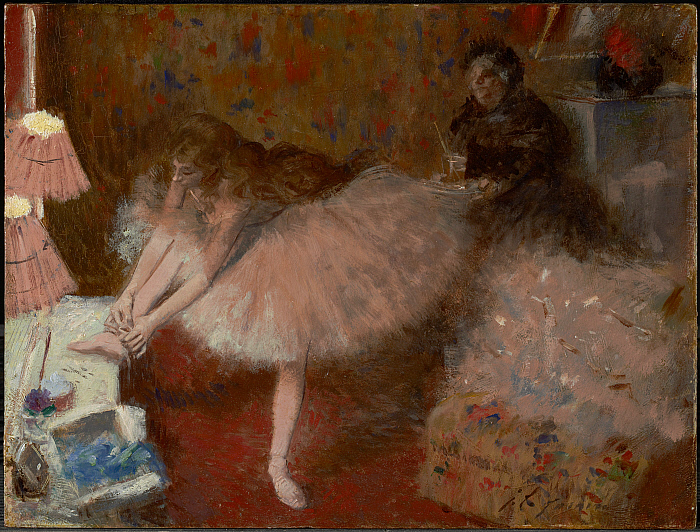May 14, 2016 - September 4, 2016
Paris had been known as the City of Light long before the widespread use of gaslight and electricity. The name arose during the Enlightenment, when philosophers made Paris a center of ideas and of metaphorical illumination. By the mid-nineteenth century, the epithet became associated with the city’s adoption of artificial lighting: in the 1840s and 1850s, gas lamps were first installed, while electric versions began to proliferate by the end of the 1870s. Even as rivals, including Berlin, London, New York, and Chicago, increased the quantity of light in their rapidly electrified cities, Paris managed to maintain its reputation because of the beauty of its illuminations. Light remained and remains to this day a key signature of the French capital.
Alfred Maurer (American, 1868-1932) Nocturne, Paris, n.d.
Oil on board, 10 1/4 x 13 3/4 in.
Avery Galleries, Bryn Mawr, Pennsylvania
Courtesy of Avery Galleries
Jean-Louis Forain (French, 1852-1931)
Dancer in Her Dressing Room, c. 1890
Oil on panel, 10 1/2 x 13 3/16 in.
Sterling and Francine Clark Art Institute, Williamstown, MA, 1955.738
Image © Sterling and Francine Clark Art Institute, Williamstown, MA (photo by Michael Agee)
Alexandre Lunois (French, 1863-1916)
Le Magasin de Nouveautés (L’Exposition du “Bon Marché”), 1903
Color lithograph on wove paper, image: 18 1/8 x 21 1/16 in.
Sterling and Francine Clark Art Institute, Williamstown, MA, 1990.14
Image © Sterling and Francine Clark Art Institute, Williamstown, MA (photo by Michael Agee)
Organized thematically into four sections––Nocturnes, Lamplit Interiors, Street Light, In and Out of the Spotlight––Electric Paris explores the ways in which artists responded to older oil and gas lamps and the newer electric lighting that began to supplant them around the turn of the twentieth century. While artificially illuminated public spaces and private interiors appear frequently in works of art and popular depictions of contemporary life during this period, the different types of lighting that animate such spaces––and their distinctive visual properties––have not been considered in detail.
Electric Paris will feature approximately 50 works––paintings, prints, photographs, and drawings––by such artists as Edgar Degas, Mary Cassatt, Pierre Bonnard, Édouard Vuillard, Henri de Toulouse-Lautrec, Charles Marville, Jean Béraud, James Tissot, Childe Hassam, Charles Courtney Curran, Alfred Maurer, and Maurice Prendergast, among others.
Theodore Earl Butler (American, 1860 - 1936 ) Place
de Rome at Night, 1905 Oil on
canvas , 23 1/2 x 28 3/4 in. Terra Foundation for American
Art, Daniel J. Terra Collection Photography ©Terra Foundation for American Art,
Chicago
Electric Paris at the Bruce Museum is curated by Margarita Karasoulas; it is an expanded version of an exhibition first organized by the Clark Art Institute in 2013, curated by S. Hollis Clayson, who is exhibition advisor to this exhibition.





